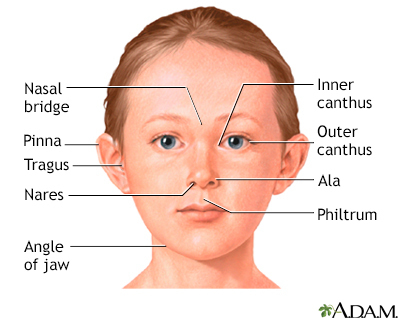Low nasal bridge
Definition
A low nasal bridge is the flattening of the top part of the nose.
Alternative Names
Saddle nose
Considerations
Genetic diseases or infections may cause decreased growth of the bridge of nose.
A decrease in the height of the bridge of nose is best seen from a side view of the face.
Causes
Causes may include:
- Cleidocranial dysostosis
- Congenital syphilis
- Down syndrome
- Normal variation
- Other syndromes that are present at birth (congenital)
- Williams syndrome
When to Contact a Medical Professional
Contact your health care provider if you have questions about the shape of your child's nose.
What to Expect at Your Office Visit
The provider will do a physical exam. The provider may ask questions about your child's family and medical history.
Laboratory studies may include:
- Chromosome studies
- Enzyme assays (blood tests to measure specific enzyme levels)
- Metabolic studies
- X-rays
Gallery


References
Farrior EH. Special rhinoplasty techniques. In: Flint PW, Francis HW, Haughey BH, et al, eds. Cummings Otolaryngology. 7th ed. Philadelphia, PA: Elsevier; 2021:chap 32.
Madan-Khetarpal S, Arnold G, Ortiz D. Genetic disorders and dysmorphic conditions. In: Zitelli BJ, McIntire SC, Nowalk AJ, Garrison J, eds. Zitelli and Davis' Atlas of Pediatric Physical Diagnosis. 8th ed. Philadelphia, PA: Elsevier; 2023:chap 1.
Slavotinek AM. Dysmorphology. In: Kliegman RM, St. Geme JW, Blum NJ, Shah SS, Tasker RC, Wilson KM, eds. Nelson Textbook of Pediatrics. 21st ed. Philadelphia, PA: Elsevier; 2020:chap 128.